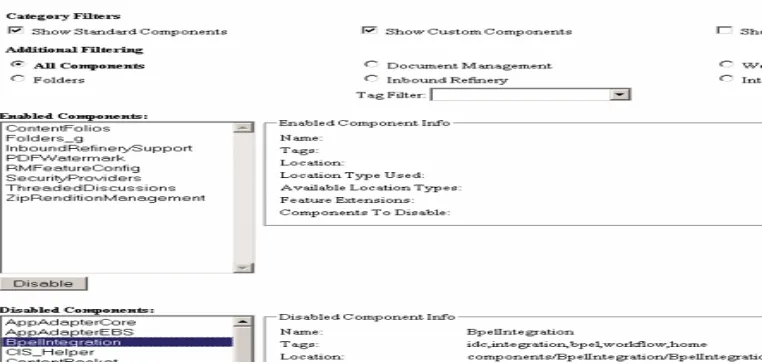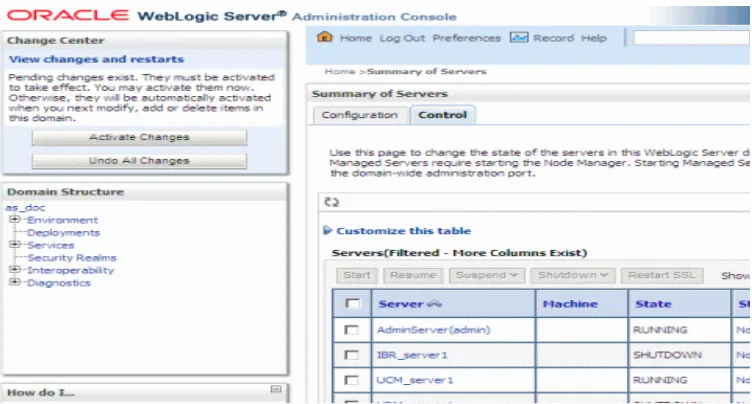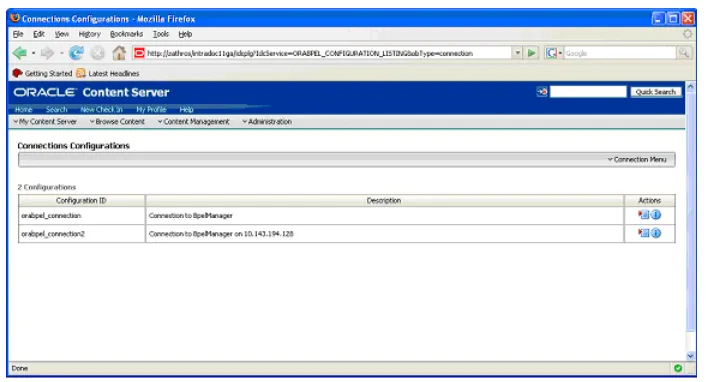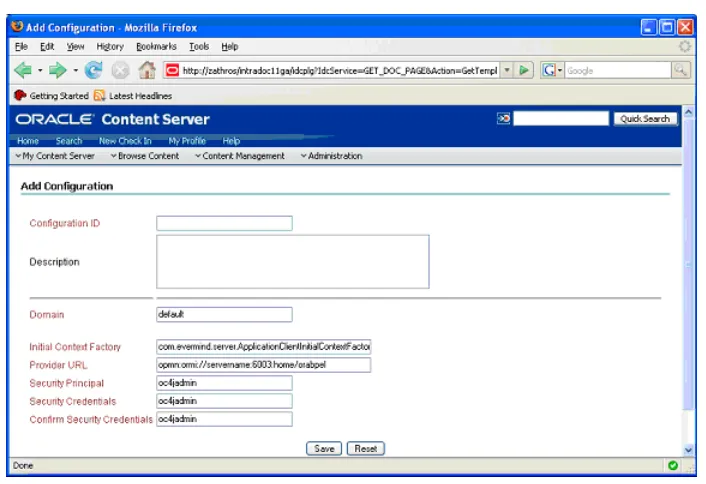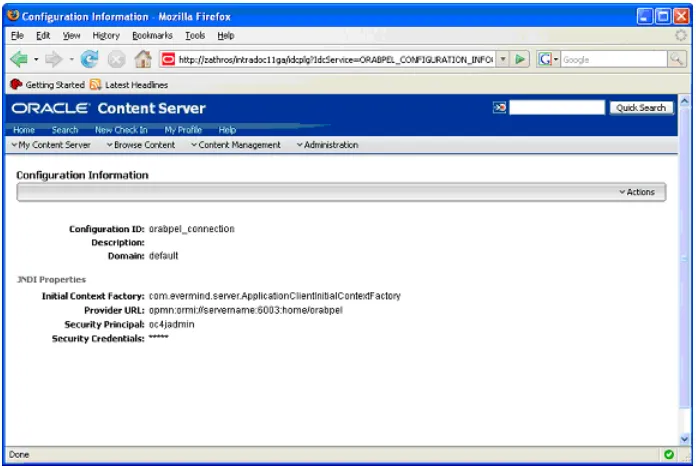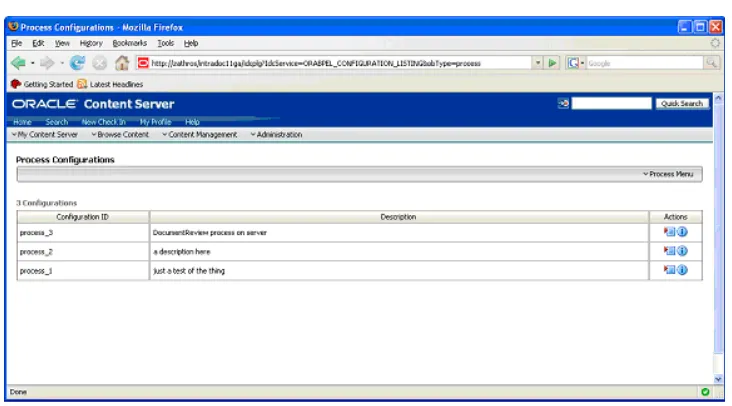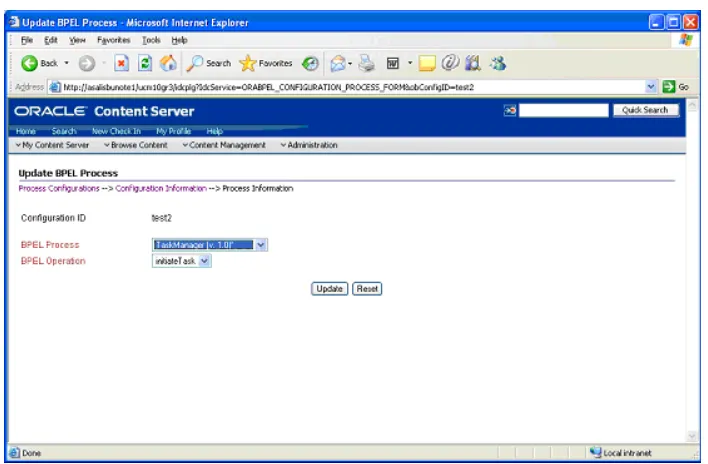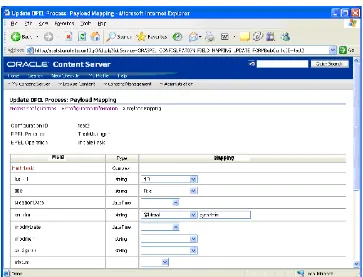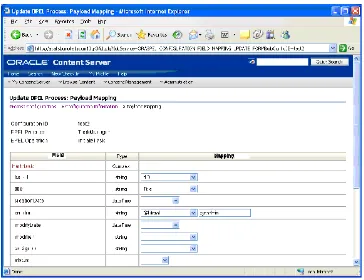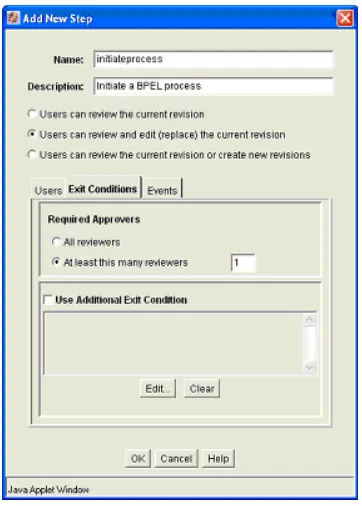Oracle® Fusion Middleware
BPEL Component Guide for Content Server
11
g
Release 1 (11.1.1)
E16759-01
Oracle Fusion Middleware BPEL Component Guide for Content Server, 11g Release 1 (11.1.1)
E16759-01
Copyright © 2010, Oracle and/or its affiliates. All rights reserved.
Primary Author: Mike Manier
Contributor: Eva Cordes
This software and related documentation are provided under a license agreement containing restrictions on use and disclosure and are protected by intellectual property laws. Except as expressly permitted in your license agreement or allowed by law, you may not use, copy, reproduce, translate, broadcast, modify, license, transmit, distribute, exhibit, perform, publish, or display any part, in any form, or by any means. Reverse engineering, disassembly, or decompilation of this software, unless required by law for interoperability, is prohibited.
The information contained herein is subject to change without notice and is not warranted to be error-free. If you find any errors, please report them to us in writing.
If this software or related documentation is delivered to the U.S. Government or anyone licensing it on behalf of the U.S. Government, the following notice is applicable:
U.S. GOVERNMENT RIGHTS Programs, software, databases, and related documentation and technical data delivered to U.S. Government customers are "commercial computer software" or "commercial technical data" pursuant to the applicable Federal Acquisition Regulation and agency-specific supplemental regulations. As such, the use, duplication, disclosure, modification, and adaptation shall be subject to the restrictions and license terms set forth in the applicable Government contract, and, to the extent applicable by the terms of the Government contract, the additional rights set forth in FAR 52.227-19, Commercial Computer Software License (December 2007). Oracle USA, Inc., 500 Oracle Parkway, Redwood City, CA 94065.
This software is developed for general use in a variety of information management applications. It is not developed or intended for use in any inherently dangerous applications, including applications which may create a risk of personal injury. If you use this software in dangerous applications, then you shall be responsible to take all appropriate fail-safe, backup, redundancy, and other measures to ensure the safe use of this software. Oracle Corporation and its affiliates disclaim any liability for any damages caused by use of this software in dangerous applications.
Oracle is a registered trademark of Oracle Corporation and/or its affiliates. Other names may be trademarks of their respective owners.
iii
Contents
Preface
... v1
Introduction
1.1 Hardware Requirements... 1-1 1.2 Software Requirements ... 1-1 1.3 Software Distribution ... 1-1
2
Installation
2.1 Integration Instructions... 2-1 2.1.1 Scenario One... 2-1 2.1.2 Scenario Two ... 2-1 2.1.3 Final Steps ... 2-2 2.2 Enabling the UCM-BPEL Integration Component... 2-2
3
Configuring UCM-BPEL Integration Component
3.1 Architecture ... 3-1 3.1.1 Connection Configuration... 3-1 3.1.1.1 Adding a Connection Configuration ... 3-2 3.1.1.2 Connection Configuration Information ... 3-4 3.2 Process Configurations ... 3-4 3.2.1 Process Properties... 3-5 3.2.2 Payload Mappings... 3-6 3.2.3 Preparing BPEL Composites for UCM Integration ... 3-8
4
Configuring a Workflow in Content Server
4.1 Configuring a Workflow... 4-1 4.2 BPEL Process Information ... 4-5 4.2.1 IdocScript Functions... 4-5
Glossary
v
Preface
The BPEL Component adds the ability to interact with Business Process Execution Language (BPEL) Process Manager from within Oracle Content Server workflows. As an administrator, you can configure Content Server workflows to initiate a deployed process on the BPEL server.
Audience
This document is intended for experienced Content Server users.
Documentation Accessibility
Our goal is to make Oracle products, services, and supporting documentation accessible to all users, including users that are disabled. To that end, our
documentation includes features that make information available to users of assistive technology. This documentation is available in HTML format, and contains markup to facilitate access by the disabled community. Accessibility standards will continue to evolve over time, and Oracle is actively engaged with other market-leading
technology vendors to address technical obstacles so that our documentation can be accessible to all of our customers. For more information, visit the Oracle Accessibility Program Web site at http://www.oracle.com/accessibility/.
Accessibility of Code Examples in Documentation
Screen readers may not always correctly read the code examples in this document. The conventions for writing code require that closing braces should appear on an
otherwise empty line; however, some screen readers may not always read a line of text that consists solely of a bracket or brace.
Accessibility of Links to External Web Sites in Documentation
This documentation may contain links to Web sites of other companies or
organizations that Oracle does not own or control. Oracle neither evaluates nor makes any representations regarding the accessibility of these Web sites.
Access to Oracle Support
Oracle customers have access to electronic support through My Oracle Support. For information, visit http://www.oracle.com/support/contact.html or visit
Related Documents
For more information, see the following documents:
■ Release Notes
■ Oracle Content Server Guide
■ Oracle BPEL Process Manager Guide
Conventions
The following text conventions are used in this document:
Convention Meaning
boldface Boldface type indicates graphical user interface elements associated with an action, or terms defined in text or the glossary.
italic Italic type indicates book titles, emphasis, or placeholder variables for which you supply particular values.
1
Introduction 1-1
1
Introduction
This component guide provides all information required to install and configure the BPEL component on a computer running the Oracle Content Server and Oracle BPEL Process Manager.
The following topics are covered in this section:
■ "Hardware Requirements" on page 1-1
■ "Software Requirements" on page 1-1
■ "Software Distribution" on page 1-1
1.1 Hardware Requirements
At a minimum, the BPEL component has the same hardware requirements as for Oracle Content Server and Oracle BPEL Process Manager.
1.2 Software Requirements
This section specifies requirements for Oracle Content Server and BPEL Process Manager.
Oracle Content Server: Oracle Content Server 11g or higher should be properly installed and running on the target computer.
Oracle BPEL Process Manager: SOA Suite 11g or higher should be properly installed and running on the target computer.
1.3 Software Distribution
2
Installation 2-1
2
Installation
These instructions assume that you have already followed the steps in the UCM-WLS Install Guide and installed the release version of SOA.
This section covers the following steps:
■ "Integration Instructions" on page 2-1
■ "Enabling the UCM-BPEL Integration Component" on page 2-2
2.1 Integration Instructions
There are currently two ways to set up a content server to be able to integrate with SOA:
■ Scenario One involves installing UCM in a domain that has been extended by SOA. This involves installing all the bits and pieces into one domain in a particular order. The SOA libraries are available to all and the class path is augmented to contain the SOA libraries.
■ Scenario Two involves manually copying the required libraries used by SOA and augmenting the class path used to launch UCM inside of WLS.
The difference between the two scenarios is that the installation of SOA augments the class path for you, while in Scenario Two this is a manual step. In the future, UCM will ship with the appropriate SOA libraries.
2.1.1 Scenario One
Follow these steps:
1. Create a new domain for SOA.
2. Extend the SOA domain by BAM and EM.
3. Extend the SOA by UCM.
You may want to check that setDomainEnv has been populated with SOA-specific libraries. In particular, check that soa-infra-mgmt.jar is mentioned in the class path.
2.1.2 Scenario Two
To update a UCM domain that has not been extended by SOA, follow these steps:
Enabling the UCM-BPEL Integration Component
home directory and leave it in the top directory, that is, copy SOA_ORACLE_ HOME/soa to UCM_ORACLE_HOME/soa.
2. Augment the class path for the UCM domain by editing the setDomanEnv.cmd or setDomainEnv.sh file, depending on your OS.
set POST_CLASSPATH=%ORACLE_HOME%\soa\modules\oracle.soa.mgmt_ 11.1.1\soa-infra-mgmt.jar;%POST_CLASSPATH%
2.1.3 Final Steps
The final step for both scenarios is enabling the BpelIngetration component and starting the servers.
If your SOA instance is running in a separate server than UCM, you may see the following security error:
vax.xml.ws.WebServiceException: java.lang.SecurityException:
[Security:090398]Invalid Subject: principals=[weblogic, Administrators]
at com.sun.xml.ws.client.dispatch.DispatchImpl.doInvoke(DispatchImpl.java:209) at com.sun.xml.ws.client.dispatch.DispatchImpl.invoke(DispatchImpl.java:216)
If you encounter this error, you need to enable cross-domain security for both servers. Follow these instructions:
User will need to setup Trusted Domain on both WLS domain. Goto WLS Console->Respected Domainssoainfra or bam ->Security 1. Make sure "Cross Domain Security Enabled"
2. Click on Save
3. Expand Advanced part of setting
4. Make sure you supplement the Credential and Confirm Credential fields. 5. Click on Save
Repeat for the same for the other WLS domain. Finally, Restart both WLS Servers.
2.2 Enabling the UCM-BPEL Integration Component
Follow these steps to enable the UCM-BPEL Integration component:
1. Log in to the Oracle Content Server as a system administrator.
2. Navigate to the Admin Server.
3. On the Administration for Servers page, select Component Manager for the server on which you want to install the component (see Figure 2–1, "Component
Enabling the UCM-BPEL Integration Component
Installation 2-3
Figure 2–1 Component Manager Page
4. In the paragraph at the top of the page, click the Advanced Component Manager link.
Figure 2–2 Advanced Component Manager Page
5. Notice that there are two lists, of Enabled and Disabled Components. Select
BpelIntegration in the lower Disabled Components list.
6. Click Enable to move the item from the lower list to the upper.
7. At the bottom of the page, click Update.
8. Log in to the Oracle WebLogic Server Administration Console.
9. In the Environment area, click the Servers link. The Summary of Servers page is displayed.
Enabling the UCM-BPEL Integration Component
3
Configuring UCM-BPEL Integration Component 3-1
3
Configuring UCM-BPEL Integration
Component
The following topics are covered in this section:
■ "Architecture" on page 3-1
■ "Process Configurations" on page 3-4
3.1 Architecture
The UCM-BPEL Integration uses BPEL client libraries to communicate with Oracle BPEL Process Manager. A process configuration is required to identify connection parameters, a BPEL process, and a BPEL operation. Additionally, a process
configuration identifies document metadata fields and literal values assigned to the parameters passed to the BPEL operation.
3.1.1 Connection Configuration
Process configurations reside within files located in the data/orabpel directory. You may edit these files manually. However, there are some pages provided with the UCM-BPEL Integration component to make this job easier. The first page is a
connection configuration page. From the connection configuration page you can view the defined connection configurations and add or delete connection configurations.
As an administrator, you can access the connection configuration page by expanding the Administration menu, and then expanding the Oracle BPEL Administration
Architecture
Figure 3–1 Connections Configurations Page
This page contains an Actions drop-down list that provides the following choices.
3.1.1.1 Adding a Connection Configuration
To add a connection configuration, choose Add Connection from the Actions drop-down list at the top of the page. The Add Configuration page is displayed.
Element Description
Add Configuration Allows you to add an additional connection configuration.
Configuration Information Allows you to view a connection configuration in more detail.
Delete Configuration Allows you to delete a connection configuration.
Architecture
Configuring UCM-BPEL Integration Component 3-3
Figure 3–2 Add Configuration Page
The fields on this page are defined in the following table.
Element Description
Configuration ID Used to identify the connection configuration. Must be unique.
Description Used to provide a description of the connection configuration.
Domain The BPEL process domain identifier.
Initial Context Factory The initial context factory to use to connect to the BPEL process manager. The value should be the fully qualified class name of the factory class that creates an initial context (for example,
"com.evermind.server.ApplicationClientInitialContextFactory " for connecting to an Oracle Application Server running BPEL).
Provider URL The location of the BPEL process manager. The value should contain a URL string (for example,
"opmn:ormi://servername:6003:home/orabpel" for connecting to an Oracle Application Server running BPEL).
Security Prinicipal The identity of the principal for authenticating the caller to the BPEL process manager. The value should contain a user identifier for a user registered on the BPEL process manager.
Security Credentials The credentials of the principal for authenticating the caller to the BPEL process manager. The value should contain a password for the user identifier entered as the security principal.
Confirm Security Credentials
Process Configurations
3.1.1.2 Connection Configuration Information
To view detailed information about a specific connection configuration, you can choose Configuration Information from the Actions popup menu for the specific adapter in the configuration page. The Configuration Information page is displayed.
Figure 3–3 Configuration Information Page
The following actions are available from the Actions drop-down at the top of the page.
3.2 Process Configurations
After the connections have been configured, processes may be defined and configured. As an administrator, you can access the connection configuration page by expanding the Administration menu, and then expanding the Oracle BPEL Administration
folder. Click Process Configurations. The Process Configurations page is displayed.
Element Description
Update Connection Allows you to edit the connection configuration.
Delete Connection Allows you to delete the connection configuration.
Process Configurations
Configuring UCM-BPEL Integration Component 3-5
Figure 3–4 Process Configurations Page
This page contains Actions drop-down lists that provide the following choices.
After you create a process configuration, you need to define process properties and payload mappings. See Process Properties for information on how to edit process properties. See Payload Mappings for information on how to edit field mappings.
3.2.1 Process Properties
Process properties identify the BPEL process and the BPEL operation used to initiate a new process. To edit process properties, choose Update Process… from the Actions menu. The Update BPEL Process page is displayed.
Element Description
Add Process Allows you to add an additional process configuration.
Configuration Information Opens the Configuration Information page for the process configuration.
Update Process Enables you to edit the BPEL process and operation.
Update Payload Enables you to edit the mappings from content item fields to payload properties.
Delete Configuration Enables you to delete the process configuration.
Process Configurations
Figure 3–5 Update BPEL Process Page
The fields on this page are defined in the following table.
3.2.2 Payload Mappings
Payload mappings define how Content Server fields and literal values are mapped to payload properties to initiate a process.
To edit payload mappings, choose Update Payload from the Actions menu. The Update BPEL Process: Payload Mapping page is displayed.
Element Description
BPEL Process The process identifier of a deployed, active BPEL process. Each active process is listed with the Process Name and Process Revision. The default revision for each process is identified with an asterisk (*).
Process Configurations
Configuring UCM-BPEL Integration Component 3-7
Figure 3–6 Update BPEL Process: Payload Mapping Page
This page displays a form with three columns. Each of the columns is defined in the following table.
Element Description
Field The name of the payload element to which values are mapped.
Type The type of payload element. This is used to filter the options displayed in the value option list. Complex types contain other types. If the type is an array of elements, then the value mapping may be a comma-separated list that is parsed by the component.
Mapping Used to identify the name of a Content Server field. These fields are the standard Content Item fields (dID, dDocName, dDocTitle, etc.), custom information fields, and some special system fields. The possible special fields are:
HttpAbsoluteCgiPath - The absolute CGI path to the Content Server.
HttpAbsoluteWebRoot - The absolute path to the Content Server web root.
idcReference - Creates a string with a value of "socket:<HttpServerAddress>:<HttpServerPort>"
DocUrl - The computed URL to the web viewable file.
Process Configurations
The following figure shows an example of field mappings.
Figure 3–7 Payload Mapping Page - Field Mappings Example
On this page, the following mapping is established:
■ The taskId payload field is assigned the value of the content's dID.
■ The title payload field is assigned the value of the content's Title.
■ The creator payload field is assigned the literal value of sysadmin.
3.2.3 Preparing BPEL Composites for UCM Integration
The UCM integration with BPEL requires that the BPEL composite has a binding.adf @Literal - Allows you to assign a literal value. When this option is chosen, an additional text entry field is displayed to provide the value. You can enter array values using
comma-separated notation.
Process Configurations
Configuring UCM-BPEL Integration Component 3-9
<binding.adf serviceName="YourUniqueServiceName" registryName=""/>
where the serviceName is something meaningful of your choosing and registryName must be empty.
A possible composite example is as follows:
<service name="receive" ui:wsdlLocation="receive.wsdl">
<interface.wsdl interface="http://oracle.com/sca/soapservice/aug11_app_ 2/myThirdComposite/receive#wsdl.interface(execute_ptt)"/>
<binding.ws port="http://oracle.com/sca/soapservice/aug11_app_ 2/myThirdComposite/receive#wsdl.endpoint(receive/execute_pt)"/> <binding.adf registryName="" serviceName="my3rdBPELService"/> </service>
4
Configuring a Workflow in Content Server 4-1
4
Configuring a Workflow in Content Server
The following topics are covered in this section:
■ "Configuring a Workflow" on page 4-1
■ "BPEL Process Information" on page 4-5
4.1 Configuring a Workflow
To integrate with BPEL process manager, you must first configure a Content Server workflow. There are many possible ways to configure a workflow. The following tasks configure the most basic type of workflow that integrates with BPEL process manager.
1. Start the Workflow Administration applet.
2. Add a new Criteria Workflow. For this example, we assume the workflow name is
orabpeltest.
3. Add a step to the workflow. For this example, we use initiateprocess as the step name.
Configuring a Workflow
Figure 4–1 Add New Step Dialog
5. Change to the Exit Conditions tab and select at least 1 reviewer. (This is an arbitrary setting, but in this instance, it leaves the content item in this workflow step after a BPEL process is initiated.)
Configuring a Workflow
Configuring a Workflow in Content Server 4-3 7. In the Edit Additional Exit Condition dialog, check the Custom Condition
Expression and add the following script:
wfGet("conversationId") and
obIsInstanceClosed("process_3", wfGet("conversationId"))
Figure 4–3 Additional Exit Condition Dialog
8. On the Events tab, click on Edit… for the Entry event.
Configuring a Workflow
Figure 4–4 Add New Step Dialog, Events Tab
9. In the Edit Script dialog, click on the Custom tab.
10. Click on the Custom Script Expression checkbox to enable the script window.
11. Type the following lines into the script window:
BPEL Process Information
Configuring a Workflow in Content Server 4-5
Figure 4–5 Edit Script Dialog
12. Click OK to finish editing the script.
13. Click OK to finish editing the workflow step.
14. Enable the workflow.
4.2 BPEL Process Information
When a content item enters the workflow and initiates a BPEL process, an identifier is created and stored in the companion data file to identify the related BPEL process. This identifier is stored with the key "conversationId" and can be obtained from the companion data with custom IdocScript in a workflow step event.
4.2.1 IdocScript Functions
The following IdocScript functions are available to use in the workflow event and extra exit condition scripts.
Note: The component defines IdocScript functions that can be used to start and determine the state of an invoked process. The
obInvokeProcess Idoc function takes the name of the process configuration ID as its one argument. Alternatively, you can use the ORABPEL_INVOKE_BPEL service. This service requires the
BPEL Process Information
obInvokeProcess[obConfigID] - This function invokes the process as defined in the process configuration.
obIsInstanceClosed[obConfigID, conversationId] - This function returns true if the process as specified by the specified configuration with the given conversation ID has been closed. Closed includes completed and cancelled.
obIsInstanceOpen[obConfigID, conversationId] - This function returns true if the process as specified in the specified configuration and the given conversation ID is open.
Glossary-1
Glossary
absolute URL
The full Internet address of a Web page. It consists of the transfer protocol, network location, and optional path and file name. For example:
http://www.company.com/news/update.htm, where ‘http’ defines the transfer protocol, ‘www.company.com’ identifies the server where the document resides, ‘news’ is a subdirectory, and ‘update.htm’ is the file name.
active link
The currently selected link on a Web page. Web browsers often display links in a different color when clicked and change the color again, once the reader has visited the site or page the link points to.
Active Server Pages
A Microsoft scripting language capable of performing server side functions with Microsoft Internet Information Server (IIS). ASP (and more recently ASP+) can be used to build dynamically assembled Web pages that draw information (using queries) from a relational database. ASP pages contain the .asp file extension.
ActiveX control
A component that can be embedded in a Web page to provide functionality not directly available in HTML, such as animation sequences and spreadsheet calculations. ActiveX controls can be activated in a number of programming languages.
Address (System)
A special element that is part of every template in Dynamic Converter. Used to format an address in a Web page, that is, the information entered under Address Lines in the Address tab dialog of the Globals property sheet.
administrator
A person or computer login that has maximum privileges over the computer or network. Administrative access includes the ability to use every Element of the system and assign unique privileges to other users.
anchor
applet
applet
Short for Java applet, a short program written in Java that is embedded in a Web page and executed by a Web browser. Java applets are frequently used to add interactivity or application functions to a Web page. Java applets can be read by Microsoft Internet Explorer, Netscape Navigator, or any Web browser capable of interpreting Java.
ASCII
American Standard Code for Information Interchange. A universally recognized text-only format that contains characters, spaces, punctuation, etc., but no formatting information. You can transfer ASCII files between programs that could not otherwise understand each other’s documents. HTML files can be encoded in ASCII format.
background color
The color setting of a Web page or table cell.
background graphic
The graphic used instead of a color for the background of a Web page. Each graphics set in Dynamic Converter includes a background graphic that is automatically applied to all Web pages created from the template the graphics set has been applied to.
base URL
An optional URL that you can assign to a Web page to convert relative URLs on the page to absolute URLs. A base URL should end with a document name, such as http://www.company.com/news.htm, or a trailing slash, such as
http://www.company.com/news/. A base URL is also called a base location.
bitmap (.bmp)
A Windows-compatible graphics file format in which the image is represented by a series of bits. Dynamic Converter converts numerous image types, including bitmaps, in source documents into the GIF, JPEG, PNG, WBMP, or BMP format.
bookmark
1) A means to store a Web site or other Internet URL for future use. Instead of entering the URL each time a user wants to visit a site, the user can open the URL once,
'bookmark' the URL, then use the bookmark to make subsequent visits. Bookmarks are also called 'Favorites.'
2) A named location on a Web page that serves as the target of another link.
Bookmarks allow you to link to a specific section of a Web page. In a URL, a bookmark is preceded by the pound (#) sign. Bookmarks are also called anchors.
broken link
directory
Glossary-3
implements CSS both the second and third way. (Outside style sheets can be added by using the "Include HTML or scripting code before content" option.)
cell
The smallest component of a table.
cell padding
The amount of space between the content and border of a table cell.
cell spacing
The amount of space between cells in a table.
character
A single alphabetic letter, numeric digit, or special symbol such as a decimal point or comma.
character element
A element used to format only characters, that is, a portion of text in a paragraph.
core HTML tags
The most commonly used HTML tags: six heading tags, the paragraph tag for all text, and two tags for handling lists.
Default Character
A special element that can be associated with any character in a source document that is not associated with a specific style.
Default Paragraph
A special element that Dynamic Converter assigns to content in a source document that is not associated with any other element.
Default.tcp
One of two default project files in Dynamic Converter. A copy of the project file opens automatically when you start a new HTML project. The project file is installed in the Dynamic Converter directory (a copy is also available in the Support folder of the Dynamic Converter product disc). A second default project file, DefaultWML.tcp, is used to create WML projects.
DefaultWML.tcp
One of two default project files that is installed in the Dynamic Converter directory (and is also available on the Dynamic Converter product disc). Dynamic Converter opens a copy of DefaultWML.tcp each time you start a new WML project.
DefaultWML.tcp is used to create WML projects. You use Default.tcp to create HTML projects.
directory
domain name
domain name
A name that resolves or points to an IP address. Domain names give a 'friendly name' to a Web site, making it easy for users to find the Web site on the World Wide Web.
download
To transfer a file from a remote computer to a local machine.
effect
A characteristic of a portion of text in a document, such as bold, italic, or subscript. Dynamic Converter lets you retain or change such effects when you translate source documents.
element
Similar to a style name used in a word-processing template. Dynamic Converter assigns elements to the ranks it creates for content in source documents. An HTML tag is assigned to each element, and the elements are saved in the template.
element button bar
A navigation aid consisting of buttons with labels such as "Previous" and "Next" to denote their purpose. Used to move between elements within Web pages.
element link
A link at the element level that allows readers to jump between content associated with a specific element in a Web page.
Element Setup
A property sheet in Template Editor in which you manage elements.
element text bar
A navigation aid consisting of text drawn from elements. Used to move between elements within Web pages.
Electronic mail. The transmission of messages electronically over a network.
Email (System)
A special element that is part of every template in Dynamic Converter. Used to format an email address in a Web page, that is, the information entered in the Email Prompt text box in the Address tab dialog of the Globals property sheet.
embedded files
Globals
Glossary-5
file
A named collection of information that is stored in a file system.
file extension
The part of a file name that identifies the purpose or use of the file. File extensions determine file type. As a result, software applications are able to read the file as necessary. For example, files with the .txt extension can be opened with a text editor; files with the .bmp extension can be opened with a graphics editor; and files with the .exe extension can be run by the operating system.
file server
A computer running on a network that stores files and provides local and remote access to them. File servers are also called Web servers.
file type
The format of a file, usually indicated by its file name extension. Most software applications work with a specific set of file types.
folder
The name of a storage area on a computer's disk drive that contains a collection of files, other folders, or both. The folder name should identify its contents. In the Windows operating system, a folder is represented by a yellow icon that resembles a manila folder. Folders are also called directories.
font
Set of characters of a particular design and size. A typeface is composed of fonts. Arial is a typeface; Arial 12 point roman bold is a font.
Formatting
A property sheet in Dynamic Converter in which you format the content of your Web pages.
Gallery
A dialog box in Template Editor that offers over 900 graphics that serve as navigation and visual aids to fine-tune the appearance of Web pages. Many of the graphics are organized in 28 Sets, which ensure that the buttons, bullets, separators, and
background in your Web page are all of a consistent design.
GIF (.gif)
Graphics Interchange Format, a compressed graphics file that handles eight-bit color (256 colors) and achieves a compression ratio of roughly 2:1. GIF images are a popular graphic file format on the Internet because of the reduced download time. GIFs are one of the default formats that Dynamic Converter uses to convert graphics imported in source documents.
global setting
Any option in Dynamic Converter set in the Globals property sheet. Associated with a specific template rather than an individual element within the template.
Globals
graphic
for all documents associated with that template, and this color will be used for all Web pages created when those documents are translated.
graphic
A particular type of file that typically displays an image rather than text. Dynamic Converter accepts graphics in a variety of formats when it translates source documents into Web pages. It converts them into the GIF, JPEG, PNG, BMP, or WBMP format. Dynamic Converter also includes a Gallery of graphics for use as navigation and visual aids in Web pages.
graphics set
A collection of graphics provided in Dynamic Converter, available from the Gallery. Each graphics set is uniquely designed and consists of a series of navigation buttons, a bullet, a separator, and a background. There are 28 Sets in Dynamic Converter.
GUI
Graphical user interface, a graphics-based user interface that incorporates icons and menus and allows users to use a mouse to execute commands. GUIs create visually oriented interfaces that make it easy for users to interact with computerized information of all kinds.
header
The initial portion of an HTML file between the <HEAD> and </HEAD> tags where titles are commonly supplied.
heading
A text style that displays in a larger typeface than the default or normal text. Headings denote hierarchy in a document. A Heading 1 is generally the largest, a Heading 2 the next largest, and so forth. A Heading tag in HTML denotes the same hierarchy.
heading level
A level in the hierarchy of a document. Heading levels help structure content. Documents often contain several heading levels with style names such as Heading 1 and Heading 2. Each heading would be set in a different font size or weight to denote its level of importance.
hotspot
A portion of text or an image that contains a link. Clicking the hotspot takes the user to related information. In Web browsers, hotspots are invisible. Users can tell that a hotspot is present by the changing appearance of the pointer.
HTM
Image tag
Glossary-7
HTML file
What Dynamic Converter produces when it translates a source document. Each HTML file displays as a Web page in a Web browser. (If a source document is split into several HTML files, each file displays as a single Web page.)
HTML format
The format used to view documents in a Web browser. Files in HTML format are text files with HTML tags assigned to blocks of text. Dynamic Converter turns source documents into body pages that are in HTML format.
HTML tags
A collection of symbols that specify the appearance and properties of a document. Web browsers interpret HTML tags and display the contents in the browser window.
HTTP
The protocol used by Web browsers and Web servers to communicate over the Internet. More specifically, a Web browser requests a document from a Web server and displays its contents using HTTP. The HTTP protocol appears at the beginning of a URL (for example, http://). The HTTP specification is maintained by the World Wide Web Consortium.
HTTPS
HTTPS is standard HTTP exchanged over an SSL-encrypted session.
link
A jump from a piece of text or image in one document to another document located within the Web page, the file system, a network, or the Internet. Dynamic Converter creates hyperlinks automatically for navigation purposes. Dynamic Converter also preserves hyperlinks in source documents that can take the user, for example, to another Web site. Hyperlinks are the primary means of navigating on the World Wide Web. Hyperlinks are also called links.
hypertext
A nonlinear way to organize information, especially text. Hypertext provides a way to adapt text, graphics, and other kinds of data for computer use so that individual data elements point to one another. Any document that contains hypertext links to other documents is a hypertext document. Most Web pages are hypertext documents.
hypertext link
A hotspot overlaid on a graphic or piece of text. Facilitates navigation within and between Web pages according to users’ interests. When readers click the hypertext link, they’re taken to another part of the Web page or Web page.
image
A graphic in GIF, JPEG, PNG, BMP, or WBMP format that can be inserted into a Web page. Dynamic Converter lets you import graphics in a variety of formats and convert them into one of these five formats.
Image tag
inline image
inline image
An image embedded in a line of text rather than its own window. Can appear by itself or merged with displayed text.
Internet
A global computer network composed of thousands of Wide Area Networks (WANs) and Local Area Networks (LANs) that use TCP\IP to provide worldwide
communication to governments, universities, businesses, organizations, and individuals. The Internet hosts the World Wide Web.
Internet address
A unique identifier for a Web site on the Internet. Users can access a Web site by entering its Internet address in a Web browser address bar or clicking a link that contains the Internet address. For example, http://www.company.com. Also known as host name or network location.
Internet Explorer
Microsoft's Web browser used to interpret HTML markup and Internet protocols (HTTP and FTP), thus allowing users to browse the World Wide Web. Dynamic Converter provides previewing capabilities of both templates and Web pages using Internet Explorer or Netscape Navigator.
Internet Information Services
Microsoft's Web server software used to deliver Web pages on the World Wide Web. IIS incorporates numerous server-side functions for its native ASP (Active Server Page) scripting language. IIS can also be used as an FTP server to transfer documents over the Internet.
intranet
One or more Web servers located inside an organization’s internal network that are used to store internal company information. Intranets generally exist as a separate Web site from an external or customer Web site. Anyone connected directly to the network, such as an employee, can access the intranet site.
IP address
A numerical address that identifies a computer on the Internet. An IP address comprises four sets of numbers (up to three digits each) separated by periods. An IP address can be used as an alternative to a domain name when the domain name is assigned a dedicated IP.
Java
metadata
Glossary-9
JavaScript
A cross-platform, Web scripting language developed by Netscape Communications and Sun Microsystems, Inc. Compared to Java, JavaScript is limited in performance because it is not compiled before execution. Basic online applications and functions can be added to Web pages with JavaScript, but the number and complexity of available application programming interface functions are fewer than those available with Java. JavaScript code can be added to existing HTML code in a Web page.
JPEG (.jpg)
Joint Photographics Experts Group. A compressed graphics file format used to display high-resolution color graphics. JPEG is a popular format for photographs and images rich in color and detail. Dynamic Converter can convert graphics in source documents into the JPEG format.
link
A pointer in one part of a Web page that a reader can click to navigate to related information in another part of the same publication or in another publication entirely. Links permit rapid, easy movement between related information and are often coded to change color once they have been selected or used on the Internet.
list
A series of related items in paragraphs, usually set off by numbers (a numbered or ordered list) or bullets (a bulleted or unordered list).
list element
An item in a list tagged with the HTML List Item tag <LI>.
local link
A link that connects two pieces of related information in the same Web page.
logging in
The process of identifying oneself to an account through a username and password.
markup
The process of embedding special characters in a text file that tells a computer
program how to handle the contents of the file itself. HTML tags are a form of markup.
markup language
A defined set of markup tags.
Meta tag
The HTML tag that must appear in the <HEAD> portion of an HTML file. A Meta tag supplies information about a Web page but does not affect its appearance.
metadata
"Data about data." In addition to content, the typical source document has a title, author, and other properties associated with it that can be used in different ways. Dynamic Converter recognizes standard and custom metadata.
named style
named style
A set of formatting characteristics that have been saved and assigned a name, and which can be applied to any paragraph in a source document. For example, Heading 1, which may be Arial 18-point bold.
navigation
The process of using links and other devices to move within and between Web pages.
Navigation
A property sheet in Dynamic Converter in which you add navigation aids to your Web page.
navigation aid
A pointer in one part of a Web page that guides readers to related information in another part of the same publication or another publication entirely. Links permit rapid, easy movement between related information. Navigation aids often come in the form of buttons with labels such as "Previous" and "Next" to denote their purpose.
navigation bar
A series of hypertext links arranged on a single line of a Web page to provide a set of navigation controls for a Web page. Dynamic Converter lets you create both button and text bars, for a Web page as a whole and for specific elements.
Netscape Navigator
Netscape's Web browser used to interpret HTML markup and Internet protocols (HTTP and FTP), thus allowing users to browse the World Wide Web. Dynamic Converter provides previewing capabilities of both templates and Web pages using Netscape Navigator or Internet Explorer.
numbered list
A series of related items in paragraphs, numbered sequentially. Also known as an ordered list.
OLE
Object Linking and Embedding. A technology or method for sharing information between applications. If a Word or Excel document in Dynamic Converter contains an embedded object, that object can be converted to a linked graphic file that targets the object in its native application.
online
pixel
Glossary-11
page button bar
A navigation aid for moving between Web pages, consisting of buttons with labels such as "Previous" and "Next" to denote their purpose.
page text bar
A navigation aid for moving between Web pages consisting of text drawn from specific elements.
paragraph
The fundamental unit of a text or word processing file that defines content. A
paragraph can be associated with only one style. In an HTML file, it is defined by the markup tag <P>.
parent directory
A directory that contains other directories. Directories are also called 'folders.'
password
A string of letters and numbers associated with a username that together make up a login. The password adds security to the login, preventing others from using it to gain access to the computer or network. A password character usually display as an asterisk (*) to prevent others from seeing or using the password.
path
The sequence of drive, directory, and subdirectory names that defines a file’s location, such as C:\Program Files\Dynamic Converter\. Also refers to the portion of a URL that identifies the folder containing a file. In
http://www.company.com/tech/more/support.htm, the path would be /tech/more/.
pattern
A set of text attributes in a source document that Dynamic Converter can identify and associate with an element. If a manually formatted source document has headings in Arial, 18-point, bold, you can base a pattern on these attributes and associate this pattern with an element. You can then use this element to format the content associated with the pattern. There are two kinds of patterns in Dynamic Converter: paragraph and character.
pattern attribute
An individual character or text attribute such as Bold used to create a pattern.
pattern string
The string of characters used by Dynamic Converter to identify a pattern in a source document. For example, the pattern string [Bullet][A-Z][A-Za-z]+ tells Dynamic Converter to search for a pattern of text in the source document that begins with a bullet, followed by an upper-case letter, followed by one or more upper-case or lower-case letters.
pixel
plug-in
plug-in
One of a set of software modules that can be integrated into a Web browser to offer a range of interactive and multimedia capabilities.
PNG (.png)
Portable Network Graphics. New graphics format designed to replace the older and simpler GIF format. Offers superior compression and display capabilities. One of five formats available in Dynamic Converter when converting graphics in source
documents.
Preview window
A window inside a dialog box that shows you what your source document will look like in a Web browser, once translated.
properties
The characteristics of a source document, element, rank, style, or pattern. For example, the name of a document is one of its properties. Properties can be viewed and edited in the various Properties dialog boxes.
property sheet
An interface in Dynamic Converter with a series of tabs that provide access to commands and options for carrying out specific tasks. Element Setup, Formatting, Navigation, and Globals are all property sheets.
protocol
A method for two devices to communicate over the Internet. A protocol is an algorithm, or step-by-step procedure, carried out by such devices. File Transfer Protocol (FTP) and HyperText Transfer Protocol (HTTP) are protocols used to transfer files over the Internet.
rank
Used by Dynamic Converter to identify the structure of a source document based on the hierarchy of content in that document. As a result, the top-level hierarchy of each source document is treated the same.
raster image
An image formed by light and dark pixels in a rectangular array, rather than by a collection of lines, as in a vector graphic.
relative URL
tab dialog
Glossary-13
RTF (.rtf)
Rich Text Format. A method of encoding text formatting and document structure using the ASCII character set. Dynamic Converter can translate source documents in RTF format.
script
A type of computer code that can be executed by a program that understands the scripting language. Unlike most computer code, a script does not need to be compiled to run. Many scripts are placed on Web servers where they are read and executed by Web browsers.
separator
A graphical aid similar to a rule that Dynamic Converter can place in a document to set off different portions of the content.
server
A computer that offers services on a network. On the Web, servers run the Web server software that responds to HTTP protocol requests and delivers Web pages.
SGML
Standard Generalized Markup Language. An ISO (International Standards Organization) markup language for defining and using a set of tags to denote the nature of document content. HTML is based on SGML.
signature
An identifier you can add to a Web page to specify such things as the Webmaster or copyright information. You do this in the Address tab dialog of the Globals property sheet.
source document
The content you want to translate into HTML as part of your overall Web site.
Dynamic Converter converts source documents from many formats into Web viewable formats. Once you translate a source document, it becomes a Web page for viewing in a Web browser.
split
The process of taking a source document and turning it into multiple Web pages to facilitate browsing and downloading. A default option in Dynamic Converter allows you to use Heading 1 to split a document into a series of Web pages, each beginning with Heading 1 content.(You can use another element if you prefer, or even multiple elements.) Another option allows you to create multiple Web pages by splitting on each hard return in the source document.
style
A set of formatting characteristics with an assigned name that defines how text appears in a document. In Dynamic Converter, there are two kinds of styles:
paragraph and character. Styles can be assembled together to make up a style sheet or Cascading Style Sheet.
tab dialog
table
table
A series of cells organized in rows and columns used to arrange data systematically. In HTML, a table can be used to organize the layout of items (text, graphics, etc.) on a Web page.
tag
The formal name for an HTML markup element. HTML tags are enclosed in angle brackets (< >). Dynamic Converter automatically generates an element for each rank it applies to source content, and then assigns an HTML tag to each element.
TCP (.tcp)
The extension for a project file created in Dynamic Converter.
TCP/IP
Transport Control Protocol/Internet Protocol, a standard format for transferring data in packets from one computer to another. This protocol is used on the Internet and other networks. The first part of this standard, TCP, constructs the data packets; the second part of this standard, IP, routes the packets from computer to computer.
template
A set of formatting and other instructions for text and images that determines how a source document will display in a Web browser once it is translated. Most of the instructions are associated with the individual elements that reside in the template, though some are associated with the template itself.
text mode
A mode of operation in which a computer or Web browser displays letters, numbers, and other characters but no graphical images. A text mode Web browser cannot display graphics without the assistance of a helper application.
thumbnail
A miniature rendering of an image used as a placeholder and linked to the full-sized image.
TIFF (.tif)
Tagged Image File Format. A tag-based image format used for the universal
interchange of digital graphics. Dynamic Converter can convert TIFF images into the GIF, JPEG, PNG, WBMP, or BMP format.
title
visited link
Glossary-15
token
A snippet of code that can be placed in an template in place of a file name or path statement. The token acts as a variable (or placeholder) for other content. This content could be a graphic file, template settings, and more. When a document is translated, the token is replaced with the correct path and file name for the content it represents.
translation
The process of creating Web pages from source documents in Dynamic Converter. The formatting and other instructions contained in a template control the translation details. The source documents remain unchanged.
transparent GIF
A specially rendered GIF image in which one ‘color’ is transparent, allowing the background to show through. This type of graphic blends with the document’s existing color scheme and provides a more professional-looking Web page. Not all Web browsers are capable of handling transparent GIFs.
UNIX
A multi-user and multitasking operating system that exists in various forms and implementations. Unix is typically used with proprietary computer and software systems and unlike Microsoft Windows, it is primarily a command line environment.
upload
To transfer a file from a local computer to a remote computer on a network or the Internet.
URL
Uniform Resource Locator. A unique address that specifies where a document can be found on the Internet along with the protocol needed to locate the document (such as HTTP or FTP). URLs tend to be quite long, and you must enter the exact address in order to view the Web site associated with the URL.
username
A string of letters (and possibly numbers) that together with a password make up a login. Your username uniquely identifies you to the computer or network you are logging on to.
VBScript
A subset of the Microsoft Visual Basic programming system. Major Web browsers can read VBScript that is embedded in a Web page. VBScript can be executed on the Web server and the Web browser machine. Microsoft ASP (Active Server Pages) supports VBScript functions.
vector graphics
An image created by a collection of lines rather than a pattern of dots (pixels), as in a raster image.
visited link
watermark
watermark
An image that appears on the background of a Web page that is used to decorate and identify the page or Web site but does not scroll as the page scrolls.
Web
An abbreviation for World Wide Web. A subset of Internet servers that support HTTP protocol and can host hypertext documents.
web browser
Software that is used to request information from the Internet, interpret HTML markup, and display Web pages to the user. Microsoft Internet Explorer and Netscape Navigator are among the most common Web browsers.
web page
A file containing HTML intended for display in a Web browser. Web sites are comprised of individual Web pages that contain hyperlinks to one another. Dynamic Converter creates Web pages and ultimately Web sites from your source documents when you translate your publication.
web server
A computer connected to the Internet that stores files and makes them available to the public. Web server software runs on top of an operating system.
web site
A collection of HTML or scripting-based Web pages that are linked together and stored on a Web server. Every Web site has a unique URL so that it can be accessed publicly on the World Wide Web.
webmaster
A person who creates and maintains the content and organization of a Web site. In Oracle’s content management system, this individual is responsible for reviewing a project on the staging server and for authorizing its final approval and release to the Web site (publishing server).
World Wide Web
A subset of Internet servers that support HTTP protocol and can host hypertext documents. Hypertext documents may contain text, pictures, sounds, and other media. Users view such documents using a Web browser. The World Wide Web is also called the 'Web.’
World Wide Web Consortium (W3C)
Index-1
Index
A
Add Configuration Page, 3-3 Add New Step Dialog, 4-2
Add New Step Dialog, Events Tab, 4-4
Add New Step Dialog, Exit Conditions Tab, 4-2 Adding a Connection Configuration, 3-2 Additional Exit Condition Dialog, 4-3 Advanced Component Manager Page, 2-3 Architecture, 3-1
Configuring a Workflow in Content Server, 4-1 Configuring UCM-BPEL Integration
Enabling the UCM-BPEL Integration Component, 2-2
Payload Mapping Page - Field Mappings Example, 3-8
Payload Mappings, 3-6
Preparing BPEL Composites for UCM Integration, 3-8 Summary of Servers Page, 2-4
U
Update BPEL Process
